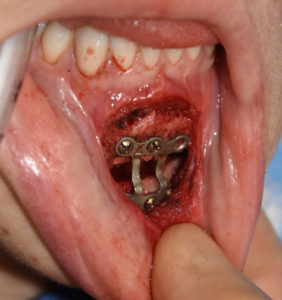Chin augmentation is traditionally thought as a choice between a chin implant and a sliding genioplasty. While seen as the two procedure choices for chin reshaping they are not really interchangeable. Besides the difference between synthetically augmenting the bone vs actually cutting and moving the bone, they can achieve different dimensional chin changes.
The one movement that a sliding or bony genioplasty can do much better than an implant is changing the vertical dimension of the chin. While it is obvious that an implant can not shorten the chin, it historically could not lengthen it very well either. That has changed more recently with vertical lengthening chin implant styles. But the intraoral genioplasty remains an historic mainstay for increasing the vertical length of the lower face. (chin)

A debatable issue with vertical chin lengthening is whether the bone ago created between the two chin segments needs to be filled in. In small gaps in the range of 5mms or less grafting of the defect is probably not needed. The body will fill it in on its own. But larger bone gaps should be grafted. I prefer to use allogeneic cadaveric bone grafts which conveniently come in wedge forms that can fit nicely as an interpositional bone graft.


